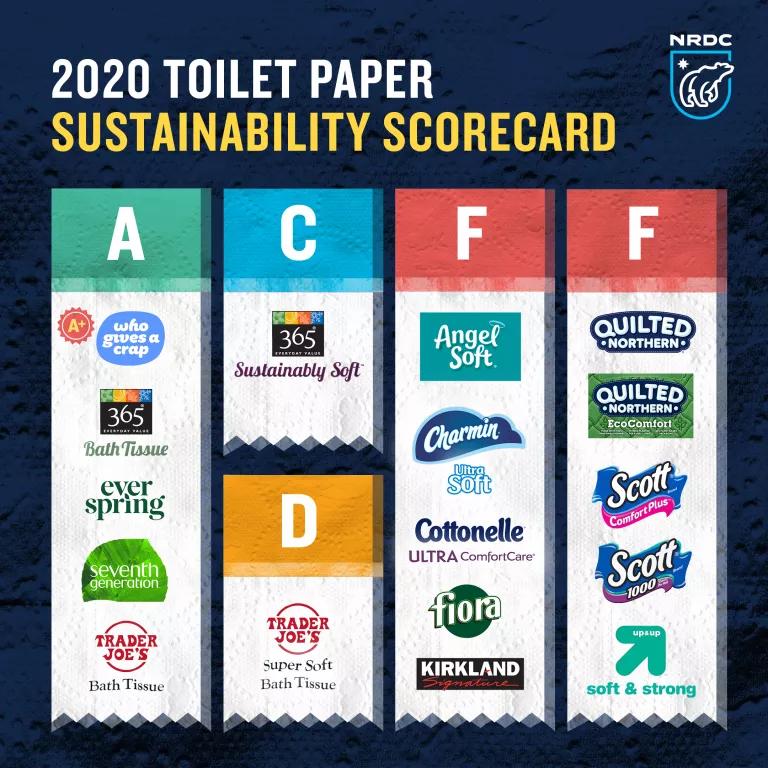This National TP Day, Unroll the Truth About Charmin

This blog has been updated to point to a video released by Stand.earth.
Despite toilet paper being top-of-mind for countless consumers in recent months, most consumers don’t know that today is National Toilet Paper Day, a “holiday” that marks a unique moment to put toilet paper back in the spotlight. While some may be “flush” with excitement, Procter & Gamble (P&G), the maker of Charmin, doesn't have much to celebrate.
As NRDC’s recent Issue with Tissue 2.0 report highlighted, P&G continues to rely entirely on virgin forest fiber to make throwaway tissue products like its Charmin toilet paper, earning the brand an “F” on our forest sustainability scorecard. The “tree-to-toilet pipeline,” which Charmin helps to fuel, devastates forests, the climate, and at-risk species. In fact, P&G’s unsustainable tissue supply chain continues to draw public attention and outrage.
That's why today, to mark National Toilet Paper Day, NRDC and partner Stand.earth are shining an even brighter spotlight on P&G’s flagrant “greenflushing” and failure to act. Stand.earth released a compelling video highlighting Charmin's role in driving forest animals to extinction, and at P&G’s Cincinnati headquarters, Stand.earth is delivering a spoof “Golden Chainsaw” award to recognize P&G's ongoing role in forest destruction. In addition, NRDC has launched a new, interactive quiz to test consumers’ ability to spot the toilet paper industry’s greenwashing. Today also marks the release of an NRDC fact sheet, You’ve Heard Charmin’s Spin; Now Here Are the Facts, which debunks misleading claims P&G uses to downplay the impacts of its tree-to-toilet pipeline.
You’ve Heard Charmin’s Spin; Now Here Are the Facts
As the largest purchaser of boreal tissue pulp in the United States, P&G makes U.S. consumers of its brands unwittingly complicit in jeopardizing some of the world’s last intact forests and the global climate. Here are some examples of how Charmin’s spin doesn’t reflect the facts:
- P&G is not a sustainability leader, and in fact lags behind its peers. Despite claims to the contrary, the company has failed to match pace with competitors who have developed high-quality, sustainable toilet paper made from recycled content or alternative fibers. Even P&G’s competitor Kimberly-Clark, maker of Kleenex and Cottonelle, has surpassed P&G by making commitments to reduce its use of virgin wood fiber and better account for the carbon footprint of its products.
- P&G is not ensuring human rights are respected throughout its supply chains. Much of Charmin’s pulp comes from forests that lack FSC certification, the only third-party forestry certification body that requires essential human rights and species protections. Without FSC certification, forestry operations in Canada and elsewhere are not required to secure free, prior, and informed consent (FPIC) from Indigenous Peoples before operating on their lands, a right enshrined in the UN Declaration on the Rights of Indigenous Peoples.
- P&G is not protecting species. Charmin’s supply chain drives clearcutting in critical boreal caribou habitat, despite scientists’ warnings that this disturbance is pushing herds to extinction and jeopardizing the health of the forest more broadly.
- P&G’s tree planting program is not mitigating its climate impact. An old-growth forest cannot simply be replanted and replaced -- a forest releases massive amounts of climate-altering carbon when clearcut, and it can take centuries for the forest to regain its previous value for the climate. Rather than increase the recycled content in Charmin and its other tissue brands, which would dramatically reduce the carbon footprints of those products, P&G continues to rely on 100 percent virgin wood fiber from climate-critical forests.
Faced with the Facts, A Growing Movement Is Demanding Change

In the face of P&G’s continued failure to address its forest and climate impacts, a growing movement is demanding change. Consumers, faith leaders, and environmental groups have called on P&G to stop destroying critical forests for toilet paper. Hundreds of thousands of people have signed petitions, and over 120 organizations, including Greenpeace, 350.org and Sierra Club, have urged P&G to create tissue products that are truly sustainable. Just this month, a segment on CBS This Morning spotlighted P&G’s role in driving intact forest loss in the Canadian boreal.
National Toilet Paper Day might just be a “cheeky” holiday, but it’s also a reminder of how harmful P&G’s toilet paper is for our forests and the need for them to join other brands in creating products that provide healthy options for consumers and the planet. Until then, consumers armed with the facts will continue mounting the pressure for P&G to show real leadership toward a sustainable future by making Charmin planet-safe -- our forests and our futures depend on it.
Take Action: Tell P&G CEO David Taylor to stop flushing the climate-critical Canadian boreal forest.





